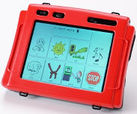INformation Hub
Assistive Technology Act
Assistive Technology Act
Updated, March 2021
As technology has come to play an increasingly important role in the lives of all persons in the United States, in the conduct of business, in the functioning of government, in the fostering of communication, in the conduct of commerce, and in the provision of education, its impact upon the lives of the more than 50,000,000 individuals with disabilities in the United States has been comparable to its impact upon the remainder of the citizens of the United States. Any development in mainstream technology would have profound implications for individuals with disabilities in the United States.
(Findings and Purposes, Assistive Technology Act of 1998, Finding 3)
The Assistive Technology Act was first passed by Congress and signed by the President as the Technology-Related Assistance Act of 1988. It’s often called the Tech Act for short and has been reauthorized in 1994, 1998, and 2004.
|
___________________________
Purpose of the Tech Act
The Tech Act is intended to promote people’s awareness of, and access to, assistive technology (AT) devices and services. The Act seeks to provide AT to persons with disabilities, so they can more fully participate in education, employment, and daily activities on a level playing field with other members of their communities. The Act covers people with disabilities of all ages, all disabilities, in all environments (early intervention, K-12, post-secondary, vocational rehabilitation, community living, aging services, etc.).
A Look at Key Definitions
The Assistive Technology Act of 2004 defines an assistive technology device in the following way:
…any item, piece of equipment, or product system, whether acquired commercially, modified, or customized, that is used to increase, maintain, or improve functional capabilities of individuals with disabilities. (29 U.S.C. Sec 2202(2))
AT devices can be “low tech,” “medium tech,” or “high tech”–as the examples below show.
- power and manual wheelchairs, scooters, canes, walkers, and standing devices
- augmentative communication devices (speech generating devices), voice amplifiers,and speech recognition devices
- durable medical equipment and medical supplies, such as patient lifts and incontinence supplies
- orthotics and prosthetics, such as hearing aids and electric larynxes
- accessibility adaptations to the home, workplace, schools, group homes, nursing facilities, ICF/MRs, and other places (e.g., ramps, stair glides, lifts, grab bars, flashing smoke detectors, lever doorknobs, and environmental controls)
- special equipment to help people work, study, and engage in recreation, such as enlarged computer keyboards, reachers, amplified telephones, magnifiers, voice recognition software, and adaptive sports equipment
- accessibility modifications in the community, such as audio systems on public transportation, talking ATMs, and voting machines for the blind (Disability Rights Network of Pennsylvania, 2008)
An assistive technology service is defined as:
…any service that directly assists an individual with a disability in the selection, acquisition, or use of an assistive technology device.
Examples of AT services–taken from the law itself–include:
An evaluation of the AT needs of an individual, including a functional evaluation of how AT would help the individual
Purchasing, leasing, or otherwise providing an AT device
Selecting, designing, fitting, customizing, adapting, applying, maintaining, repairing, replacing, or donating an AT device
Coordinating and using therapies, such as occupational therapy or physical therapy, with AT devices under an educational plan or rehabilitative plan
Training or technical assistance for an individual with a disability, or his or her family members, guardians, advocates, or authorized representatives
Training or technical assistance for educational or rehabilitation professionals, manufacturers of AT devices, employers, providers of training and employment services, and others who help individuals with disabilities
A service that expands access to technology, including email and Internet, to persons with disabilities.
State AT Projects
Under the law, each U.S. state and territory receives a grant to fund an Assistive Technology Act Project (ATAP). These projects provide services to persons with disabilities for their entire life span, as well as to their families or guardians, service providers, and agencies and other entities that are involved in providing services such as education and employment to persons with disabilities.
How do you find your state’s AT project? Visit the National Assistive Technology Act Technical Assistance and Training (AT3) Center, select the directory for State AT Programs (Step 1) and then specify your state (Step 2).
https://www.at3center.net/stateprogram
To Read the Statute of the Act
The statute of the Tech Act is the bill that was passed by Congress into law and signed by the President. As mentioned above, the most recent reauthorization took place in 2004 as Public Law 108-364. Officially, this last reauthorization of the Act is called The Improving Access to Assistive Technology for Individuals with Disabilities Act of 2004. You can find a copy of the statute online:
Summaries of the Law
AT Act Frequently Asked Questions
https://www.at3center.net/repository/atactinformation#AT%20Act%20Frequently%20Asked%20Questions
Assistive Technology Services Flowchart (PDF)
How do you access information about and acquire assistive technology devices for yourself, family members, or clients to enhance life, work, and play?
https://www.at3center.net/Content/EOCONTENTMEDIACENTER/documents/Learn%20About%20the%20AT%20Act/AT%20Flow%20Chart.pdf
Information about Assistive Technology
Listed in alphabetical order…
AccessIT: The National Center on Accessible Information Technology in Education | https://www.washington.edu/doit/programs/accessit
Assistive Technology for Kids with Learning Disabilities | https://www.readingrockets.org/article/assistive-technology-kids-learning-disabilities-overview
Assistive Technology Industry Association | https://www.atia.org/
Center for Inclusive Technology and Education Systems | https://cites.cast.org/
Connect Module on Assistive Technology | https://connectmodules.dec-sped.org/connect-modules/learners/module-5/
IRIS Center | 2 training modules on AT: An overview and all about Bookshare, which provides books in digitized formats to individuals who have print disabilities
https://iris.peabody.vanderbilt.edu/resources/iris-resource-locator/ (look under “Assistive Technology”)
National Center on Accessible Educational Materials (AEM) | https://aem.cast.org/
RehabTool | http://www.rehabtool.com/at.html
References
Disability Rights Network of Pennsylvania. (2008). Assistive technology for persons with disabilities: An overview. No longer available online.
SOURCE ARTICLE: Center for Parent Information & Resources
Give us a call at (727) 523-1130 or (800) 825-5736 or request a callback by clicking below.
311 South Missouri Ave, Clearwater, FL 33756
(727) 523-1130
(800) 825-5736


